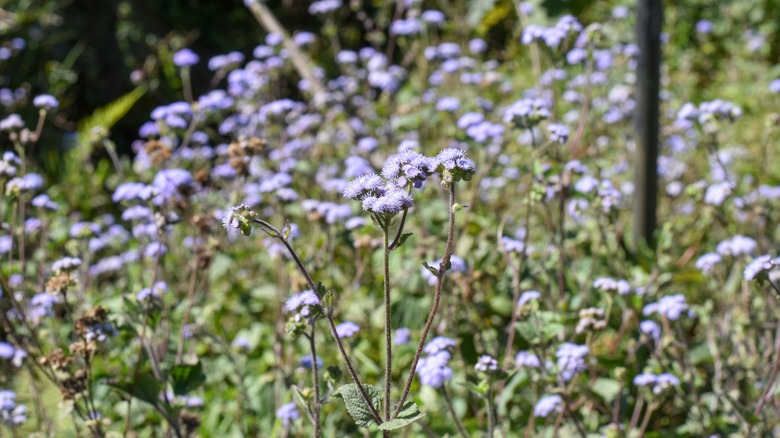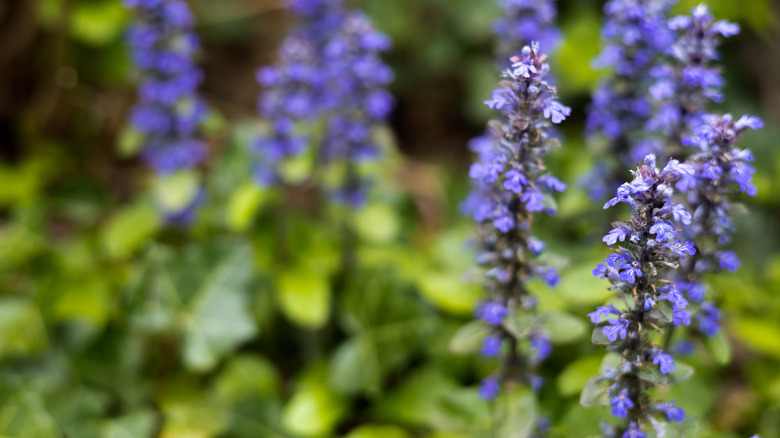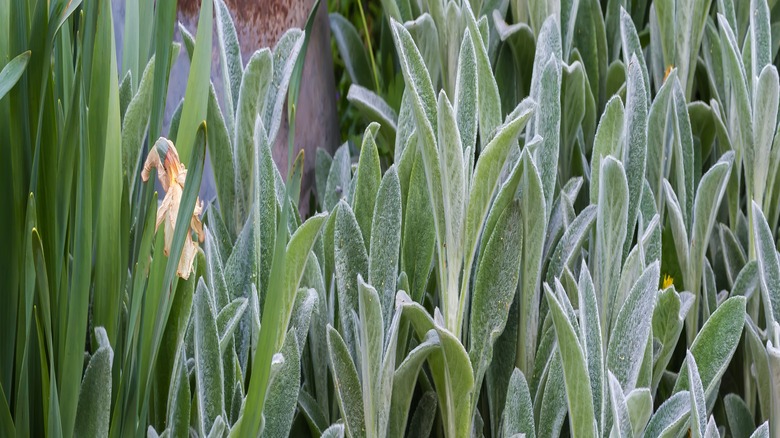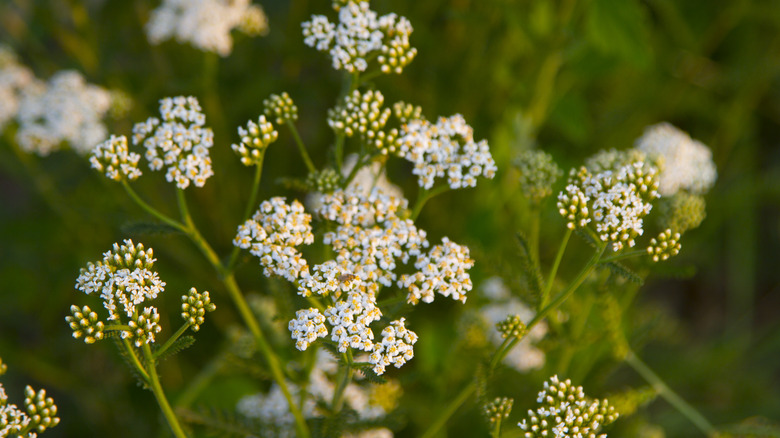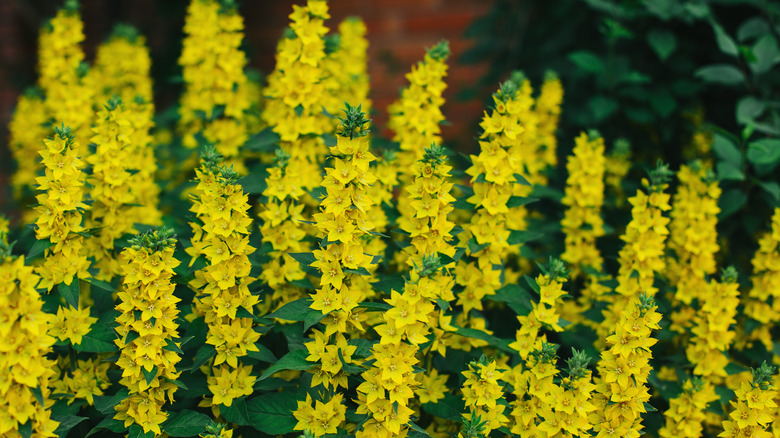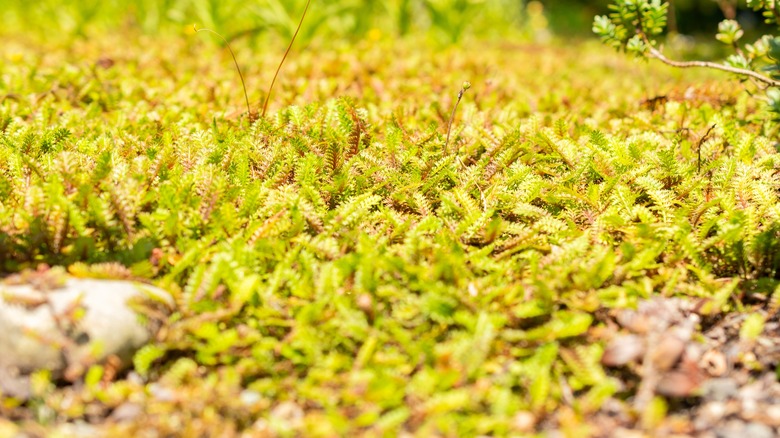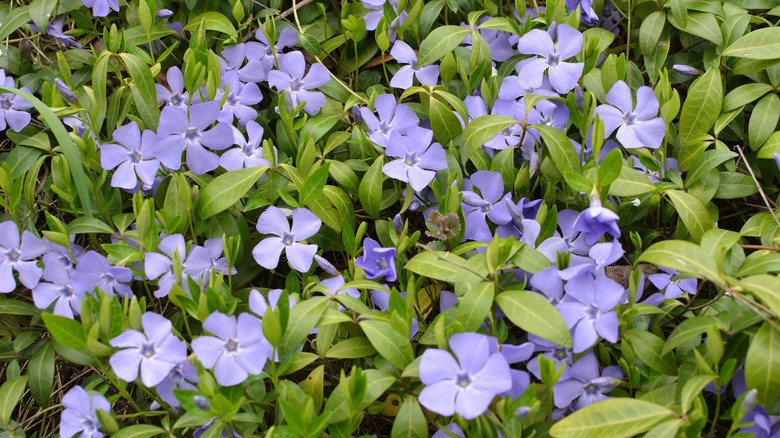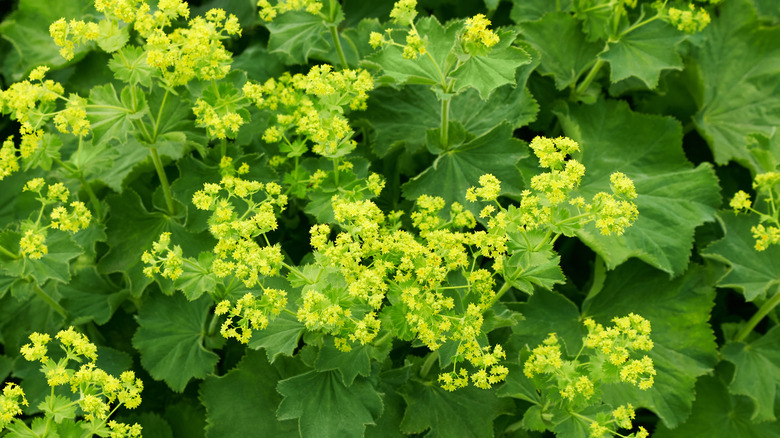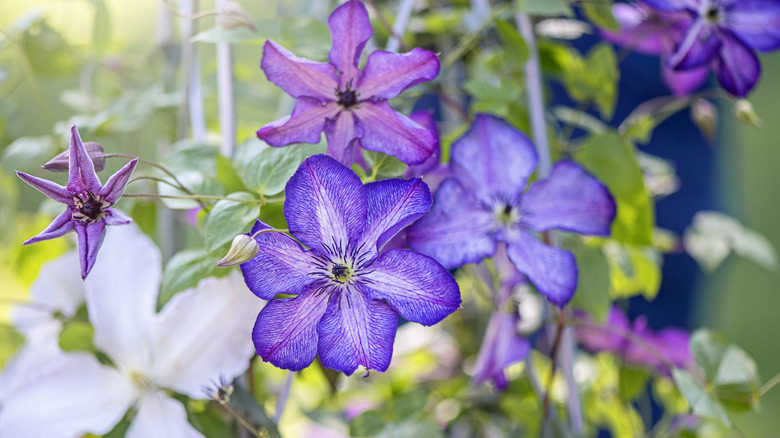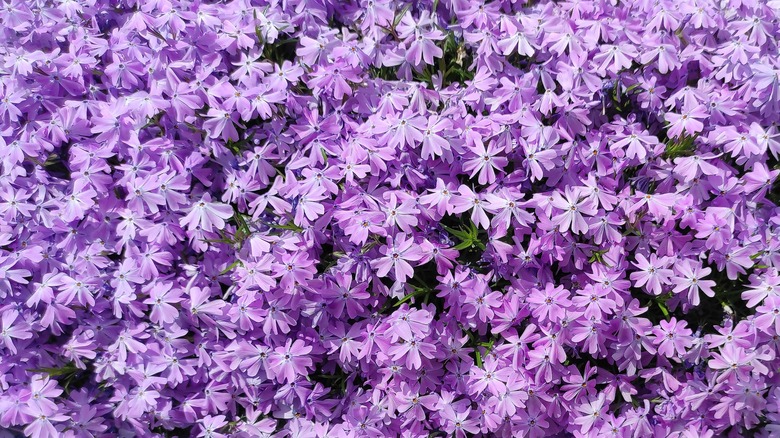Common Weed-Suppressing Plants That Can Become Nuisances Themselves
Ground cover and self-seeding plants are great because they do a lot of heavy lifting for us in the garden. Not only will they readily cover up bare spots that would otherwise be overrun by weeds, but they'll quickly fill in a newly planted garden and make us look like we knew what we were doing all along. But sometimes, too much of a good thing becomes a nightmare to control. Suddenly, those happy helper plants that were supposed to lighten the load on weed chores become fast-spreading invasive ground covers.
At this point, they might as well be considered weeds themselves, due to how much of a battle it takes to keep them under control. So, rather than dealing with a future of you versus the garden, let's plan things the right way and make sure you know what you're getting yourself into. Here are some commonly-used weed-suppressing plants that can easily overtake your garden if you're not careful.
Nasturtiums can take over thanks to their strong self-seeding abilities
Nasturtiums (Tropaeolum majus) are workhorses in a garden. They're hardy flowers that even the worst gardeners can handle, often being used as "trap crops" that lure away pests from more highly-prized flowers or crops. They can handle nearly any terrain easily. They'll sprawl, crawl, climb, and carpet any spot you let them, unfurling bright green, wide leaves that beat weeds to the photosynthesizing punch. Nasturtiums will grow up to 10 feet high or wide to showcase their gorgeous bright red, orange, and yellow blooms. But their hardiness is what makes them so hard to tame, as they will exhaust you with their ability to be prolific self-seeders. So, think carefully about how much you really love nasturtiums before planting them, because this could be a long term relationship whether you like it or not.
Your best method for keeping nasturtiums under control is only planting them in colder climates. In some warmer climates, they are considered invasive because they will self-seed year-round, so your only hope for controlling them is by having a winter dormancy period to attack. If you're living somewhere warm and still want nasturtiums, consider keeping them in containers or raised garden beds to prevent them from spreading. Also, be mindful of handling them; they can cause some people with skin sensitivities to have an allergic reaction.
Blue mistflower's rhizomes are hard to control
Blue mistflower (Conoclinium coelestinum), also known as "Hardy Ageratums," are perennial flowers that grow as solid masses, making them great for dominating wispy weeds. They love moist areas and are lovely additions in butterfly gardens, reaching up to 2 feet high and wide with purple clusters of flowers. But their rhizomes and seeds are built to dominate, and they'll suffocate weeds, flowers, shrubs, and whatever else is in their way. Rhizomes are particularly hard to defeat, as even a tiny piece left in the soil can regenerate a plant, making the mistflower like your very own garden "Terminator."
To curb mistflower's growth, cut the plant back after it flowers to prevent it from re-seeding. This will also encourage it to stay on the bushier side instead of getting a little too leggy. If you want to pull it up completely, dig a wide hole around the entire plant and dig deep to ensure you get the whole rhizome. Keep an eye out in the spring for new growth in case any bits of rhizome were left in the dirt, and pull it out quickly — roots and all.
Bugleweed's runners can give you a run for your money
Bugleweed (Ajuga reptans) is an excellent weed-suppressing, deer-resistant ground cover for shady areas. It forms a dense mat and shoots up spikes of bright purple flowers that make a perfect replacement when you want to grow lavender, but don't have the sandy soil and bright light requirements it needs to thrive. To grow, bugleweed sends out runners, sort of like how a strawberry plant does, known as "stolons," that look for new places to set up shop. These runners will root quickly and form the aforementioned mats that suffocate out weeds; that's the good news. The bad news is that those runners don't know or care where you'd like them to go, so they could get in the way, growing across paths, walkways, or over borders and fences if you don't intervene quickly.
To curb bugleweed's growth, divide the plants in spring or fall. Cutting off its flowers would also prevent it from seeding, which could slow its spread, too. If none of that works, trim the stolons as you see them spreading; you'll just have to keep at it during the plant's growing seasons.
Lamb's ear will invade grassy areas if you let it
Lamb's ear (Stachys byzantina) is from the mint family and gets its name thanks to its unique leaves. The velvety green leaves look like they've been dusted with silver and are soft to the touch, making them great for sensory or children's gardens. While it will flower, most experts recommend removing them to enhance the foliage instead. Lamb's ear grows up to 15 inches tall and spreads via creeping stems, creating a dense mat that causes weeds to be powerless against its heavy foliage. However, it can overtake lawns if you're not careful, suffocating grasses or other delicate plants with those dense, hefty leaves.
Luckily, lamb's ear is easy to keep under control, since it spreads via branching at nodes, similar to a tradescantia/spiderwort, and not underground like some of the other ground covers mentioned here. Simply cut any offshoots back that are getting a little too off course, and the plant should be okay.
Yarrow's rhizomes are underground bullies
Yarrow (Achillea millefolium) is part of the daisy family and is a popular flower for butterfly or bouquet gardens. It forms mats of foliage that support over 100 species of insects, making it one of the esteemed flowers on the Royal Horticultural Society's "Plants for Pollinators" list. Those mats not only support wildlife, but they also stamp out weeds by outpacing other plants' growths. They aggressively self-seed, and their rhizome's abilities to spread quickly are hard to match. Consequently, they are difficult to get rid of once they're established and can become not only a nuisance, but an eyesore in your garden at the end of summer post-bloom.
Yarrow is not easy to remove, so prepare for a long battle if you're up against it. Your best shot at getting rid of yarrow is not by offense, but by defense. Yarrow has a hard time competing against dense, healthy patches of grass, so focus on keeping your lawn healthy to control its spread. For garden beds, use a hand or border to remove patches of the plant, making sure to get as much of the root and rhizome out as possible. Mow down any patches you can to prevent upshoots from photosynthesizing or flowering. Do not use a weed killer; yarrow is resistant to most of them.
Creeping jenny roots faster than you can manage
You might know creeping jenny (Lysimachia nummularia) by one of its other names: "Moneywort," "Creeping Joan," "Creeping Charlie," "Wandering Jenny," or the perplexing "Wandering Sailor." Regardless of what you call it, those bright yellow flowers might only rise a few inches high, but their cheery demeanor hides an ambitious nature. Creeping jenny moves fast, crawling over weeds and rooting quickly once a node contacts soil. It then spreads out a broad mat that suffocates anything it happened to creep over, which is great for a patch of weeds, but bad for a thoughtfully planned garden.
Creeping jenny isn't leaving without a fight, but it can be overtaken if you're vigilant. For small patches, opt for manual removal — just be sure to get as many stems, roots, and fragments as possible; otherwise, you might need to do it again. For larger patches, try planting native grasses that can outgrow it and prevent the flowers from getting the light they need to photosynthesize. Submerging it in water would also kill it, though that might be easier in theory than in practice, especially if it's a large, dense mat.
Brass buttons will spread indefinitely if you let it
Brass buttons (Leptinella squalida) is an easy to grow ground cover from New Zealand. It grows only 2 inches high and forms a mat of yellow-green, fern-like leaves. It will occasionally flower yellow, button-like flowers, but most growers don't consider them to be anything of value; brass buttons is better used to carpet areas and carpet them fast. It sends runners out quickly just under and over the soil's surface, aggressively covering sunny spots in the landscape and preventing weeds from getting a foothold. However, brass buttons can grow so aggressively that their spread is considered by the Missouri Botanical Garden to last, terrifyingly, "indefinitely."
Brass button is another one that's tough to get rid of once it's established. It's intolerant of droughts, though, so start by cutting off its water supply. It can manage some foot traffic, but too much will most likely stress out its shallow roots, so consider having your pets run around its mat for a few weeks to help break up the runners.
Periwinkle can root at the nodes and spread fast
Periwinkles (Vinca minor) are just lovely. They're perennial evergreen ground covers that look innocent enough, with those pale purple flowers and low carpets of leaves. It's no surprise that they're such a popular pick for ground covers; you'd be hard-pressed to find a prettier plant. But looks can be deceiving, and periwinkle can go from a delicate little plant to a weedy, high-maintenance headache faster than you think. Periwinkle spreads by branching out and rooting at the nodes, making it easy for the plant to form a dense mat that quickly dominates any area it wants, taking down not only weeds, but much-needed native plants, too. It's such a pain to deal with that this pretty little plant is on many states' "thanks, but no thanks" lists for invasive species.
The best way to avoid the nuisance of periwinkle is to avoid using them altogether and opt for native ground cover species instead. In reality, the biggest challenge you'll face is its ability to root at the nodes, so you'll need to tackle this issue head-on. Some gardeners have mentioned using rakes to raise the stolons (runners) and then mowing the area worked, but it had to be done multiple times to be effective. Putting plastic sheeting over the area to suffocate the plant could also work, though this could take four to six months of consistent sheeting before the plant is completely dead.
Lady's mantle is hardy and a prolific self-seeder
Lady's mantle (Alchemilla mollis) is a member of the rose family and gets its species name ("mollis" or "soft") thanks to its soft, downy leaves. It's hardy in USDA Zones 3 through 8 and will form dense mounds that grow 12 inches both high and wide, which makes it a popular pick for suppressing weeds in gardens. Lady's mantle is tolerant of most light conditions and prefers moist soil, but will take whatever you've got, really. Its easygoing nature might make it seem like it's easily controlled, but that's far from the truth. Lady's mantle is an aggressive self-seeder thanks to those pretty chartreuse flowers that reach up to 18 inches in height during the summer and spread their seeds fast and far.
To keep your lady's mantle nice and neat, deadhead it quickly after it flowers. This will not only prevent it from self-seeding, but will encourage new growth, giving you a little show late in the season. If its mounds are getting out of control, you can divide the plant by splitting the clumps into separate plants with a sharp spade or dig it up completely. Be sure to completely remove the roots and stems to ensure it doesn't come back.
Some clematis cultivars are aggressive growers
The colors and sizes of the various clematis flowers make it hard to compete with; no wonder it's called the "Queen of the Vines." There are dozens of cultivars of clematis available that can help replace a weed-filled eyesore with a beautiful burst of purple, pink, and white blooms. However, the reason we're not singling out one clematis cultivar in particular is because there are a few that you need to steer clear of, especially if you're using them for weed control. In particular, oriental clematis (Clematis orientalis), Japanese clematis (Clematis terniflora), Traveler's Joy/Old Man's Beard (Clematis vitalba) are strains considered to be invasive and prohibited for sale or use in some states around the U.S. due to their difficulty to control and ability to outcompete and kill native plants.
If you'd like to use clematis for weed control, consider Virginia clematis (Clematis virginiana), sapphire indigo clematis (Cleminov 51), or bush clematis (Clematis recta). These are all flowering vines that can grow on the ground as covers to suppress weeds or on trellises as vines and are not currently considered to be invasive plants by any state.
Creeping phlox can get aggressive when happy
Creeping phlox (Phlox stolonifera) is probably the least concerning plant on this list, which is why we saved it for last. It's a native ground cover of the Appalachian Mountains that spreads its stolons quickly over the soil, preventing pesky weeds in the garden with its dense foliage of pretty purple and pink flowers. It likes moist, well-draining soil and does best in partial shade, spreading up to 3 feet per colony, if you let it. While it can become a nuisance and grow into places it's not wanted, creeping phlox is easily tamed and requires optimal growing conditions before it gets out of hand.
If you notice your creeping phlox has begun to creep a little too much, there are a few easy ways to tame it. Young creeping phlox plants do not tolerate droughts, so cut back on watering (established plants can handle droughts, so you're out of luck there). New shoots root at the nodes, so prune back any leggy stems and it will stay bushy where you want it to. If you want to be rid of it completely, creeping phlox will tolerate some foot traffic, but not a lot, so have your pets and kids walk over it to disrupt the roots and then try to pull it out.


